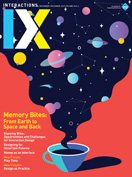Authors:
Marianna Obrist, Carlos Velasco
Imagine yourself on a NASA one-year mission to the International Space Station (ISS), with just a few crewmates in a small, isolated environment that blurs the line between familiar and unfamiliar. You have access to food for sustenance, but its appearance, taste, and the way you interact with it are all different from on Earth. Your senses adapt to the unique environment, as the specially designed food serves its functional purpose of delivering the nutrients that you need, considering the limited availability of resources. Beyond its nutritional value, though, food holds a profound significance in human society. Think of…
You must be a member of SIGCHI, a subscriber to ACM's Digital Library, or an interactions subscriber to read the full text of this article.
GET ACCESS
Join ACM SIGCHIIn addition to all of the professional benefits of being a SIGCHI member, members get full access to interactions online content and receive the print version of the magazine bimonthly.
Subscribe to the ACM Digital Library
Get access to all interactions content online and the entire archive of ACM publications dating back to 1954. (Please check with your institution to see if it already has a subscription.)
Subscribe to interactions
Get full access to interactions online content and receive the print version of the magazine bimonthly.






